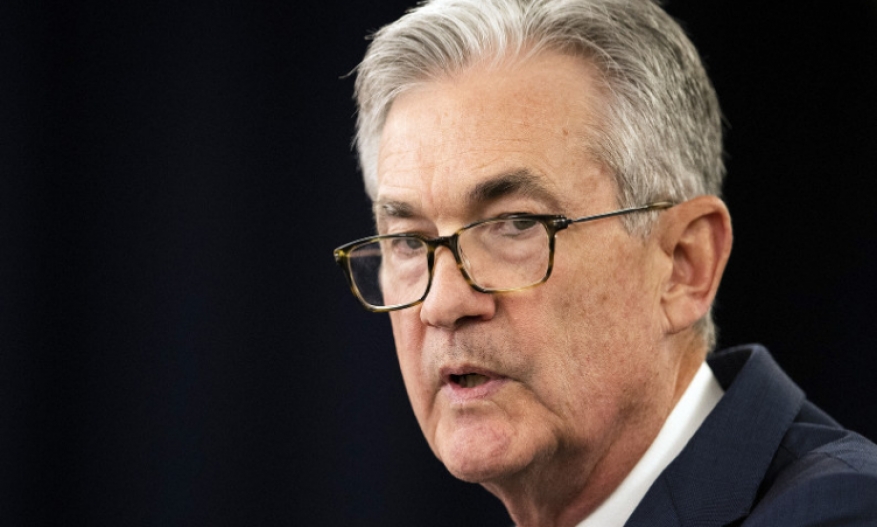 In this July 31, 2019, file photo Federal Reserve Chairman Jerome Powell speaks during a news conference following a two-day Federal Open Market Committee meeting in Washington. (AP Photo/Manuel Balce Ceneta)
In this July 31, 2019, file photo Federal Reserve Chairman Jerome Powell speaks during a news conference following a two-day Federal Open Market Committee meeting in Washington. (AP Photo/Manuel Balce Ceneta)
Fed officials widely divided on rates at July meeting
WASHINGTON (AP) -- Federal Reserve officials were widely divided at their meeting last month when they decided to cut rates for the first time in a decade, with some arguing for a bigger rate cut while others insisted the Fed should not cut rates at all.The minutes of the July 30-31 discussions released Wednesday show two officials believed the Fed should cut its benchmark policy rate by a half-percentage point, double the quarter-point reduction the central bank eventually agreed upon. On the other end, some Fed officials argued for no rate cut at all, believing that the economy was beginning to improve after a soft patch in the spring.
The minutes did not indicate any consensus on the pace of future cuts.
Financial markets have been turbulent since the July 31 rate cut, diving 800 points one day last week on the Dow Jones Industrial Average, as bad news has piled up in terms of the slowing global economy and the latest developments in President Donald Trump's trade war with China.
Because of these developments, investors have become convinced the central bank will follow up the July rate cut with further cuts at coming meetings. But private economists are not so sure, believing the Fed may want to save some of its rate cut ammunition should the economy take a serious turn for the worse with the possibility of a recession.
The minutes provided little clarity on what the future course for rates will be, but markets are hoping that Fed Chairman Jerome Powell may send a stronger signal about future rate hikes when he delivers the keynote address at the Fed's annual policy conference at Jackson Hole, Wyoming, on Friday.
"There is little sign that the Fed is willing to push back on the markets," said Michael Pearce, senior economist at Capital Economics. "As such, another (quarter-point) cut in September still looks like a good bet, if only because the Fed will not want to disappoint lofty market expectations."
The two Fed officials who argued for a bigger rate cut "favored a stronger action to better address the stubbornly low inflation rates of the past several years," the minutes said.
The July action was approved on an 8-2 vote with Esther George, president of the Fed's Kansas City regional bank, and Eric Rosengren, president of the Boston Fed, dissenting and arguing that they favored no rate cut at all.
The minutes said the majority view supported a quarter-point cut, viewing it as a "mid-cycle adjustment," a phrase Powell used in his press conference that caused an adverse market reaction by investors hoping the July cut will be the first in a series of rate reductions.
The minutes highlighted three main reasons for the cut, including recent signs of deceleration of the economy and concerns about persistently low inflation. Officials also believed a rate cut would be a "prudent step from a risk-management perspective."
The minutes said the Fed was worried about a slowdown in business investment and the global headwinds that are affecting Europe, Japan and other regions.
"Participants were mindful that trade tensions were far from settled and that trade uncertainties could intensify again," the minutes said.
On Aug. 1, the day after the Fed's rate cut, Trump announced that he would impose 10 percent tariffs on $300 billion in Chinese imports in an effort to force the Chinese to make more trade concessions at the bargaining table. Since that announcement, Trump has said he would postpone about half of those tariffs until Dec. 15 to avoid hurting American consumers during the holiday shopping season.
But economists are warning that the tariffs already imposed will likely slow U.S. growth in coming quarters.
Source: https://mainichi.jp/english/articles/20190822/p2g/00m/0bu/048000c
 English
English Japan
Japan

best natural male erectile supplements viagra active ingredient generic buy viagra cheap viagra for prostate health xanax grapefruit warning
canadian pharmacy no scripts - tadalafil canadian pharmacy reliable canadian pharmacy reviews
ed meds online without doctor prescription tadalafil 20 mg reviews womens viagra how to take viagra for best results fda approved appetite suppressant otc rhino pills for men wholesale viagra connect walgreens marley drug consumer complaints does walgreens accept medicare gnc cialis substitute fda approved drug database sildenafil viagra walmart 4 dollar list the red pill for ed viagra pills for men natural viagra alternatives that work best diet pills that work side effects for flomax viagra cvs cost of cialis 20 mg tablets is there a herbal viagra women using viagra experiences how to increase viagra effectiveness natural alternatives to viagra best vitamins for male libido the blue pill for women how to increase women's libido naturally bayer samples for healthcare professionals viagra cialis herbs for women's libido generic viagra in usa store pfizer viagra price walgreens supplement scam vitamins help erectile dysfunction
cheapest tadalafil india - cialis without prescription viagra over the counter in us
ivermectin 3 mg over the counter - ivermectin 3 mg for humans for sale ivermectin uk
viagra compared to cialis dosage buy male enhancement pills is generic viagra available viagra meaning viagra and prostate cancer risk purple viagra pills 100 mg free printable manufacturers coupons
gambling casino - best real money casino online casinos for usa players
buy amoxicillin 1000mg canada - kroger amoxicillin price amoxil rash
accutane prescription nz - accutplus isotretinoin for sale
how do birth control pills prevent pregnancy generic viagra 100 mg best price best generic viagra websites viagra danger myths trulicity patient assistance program pdf cialis male enhancement pills